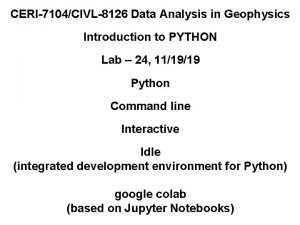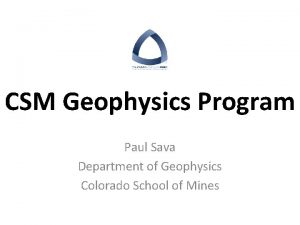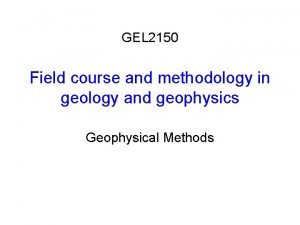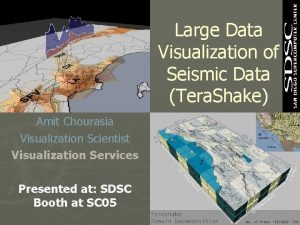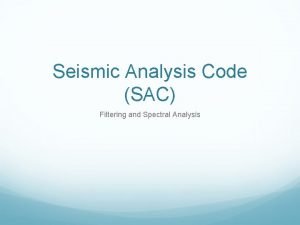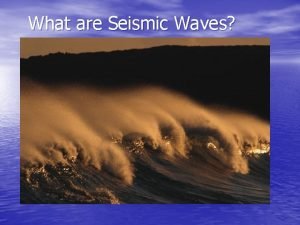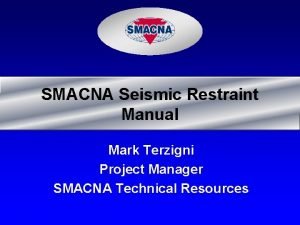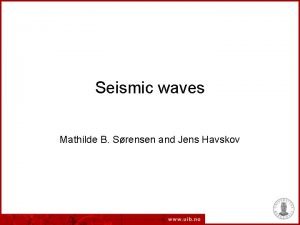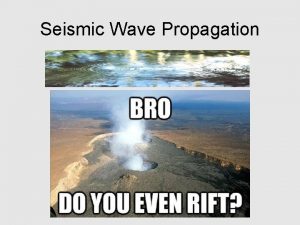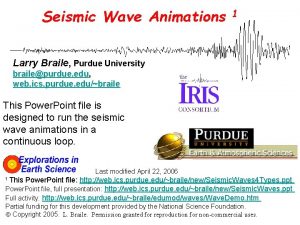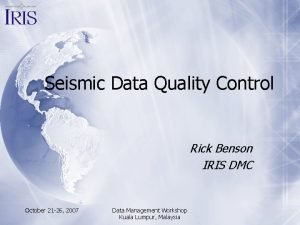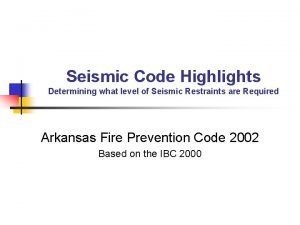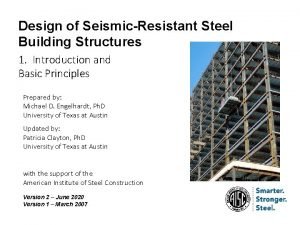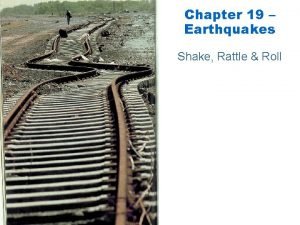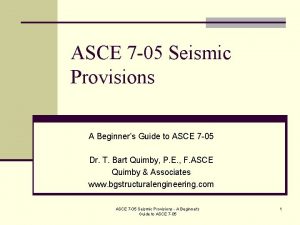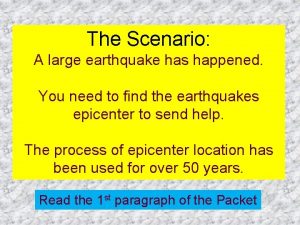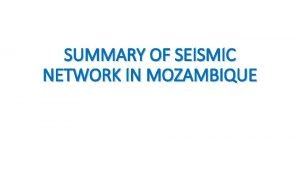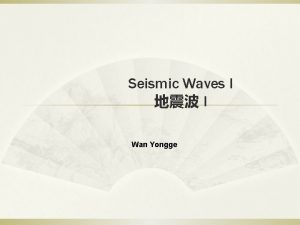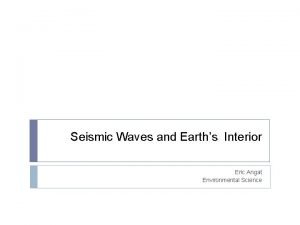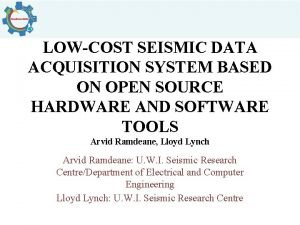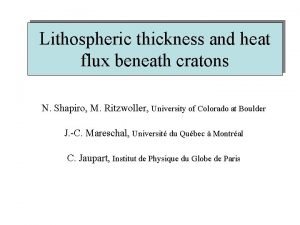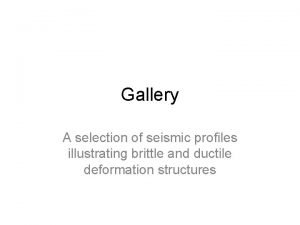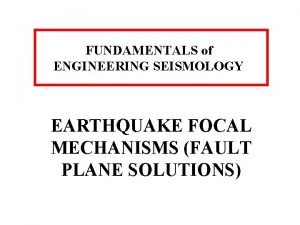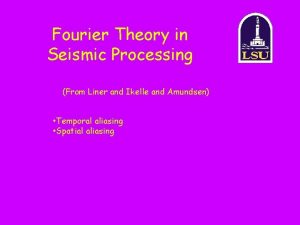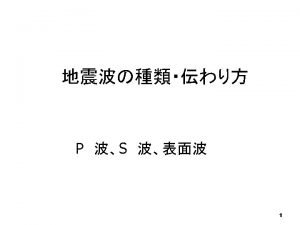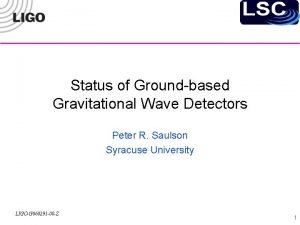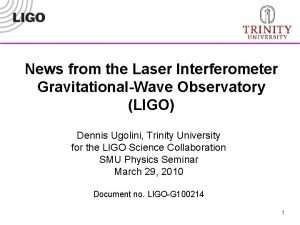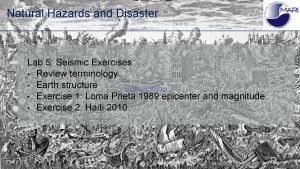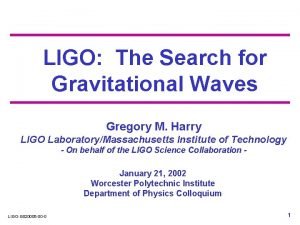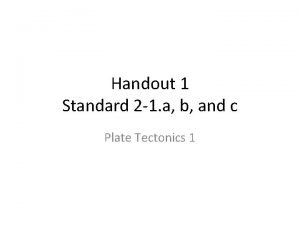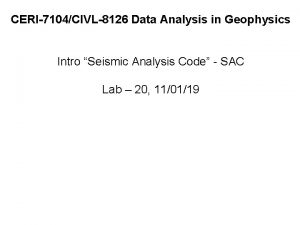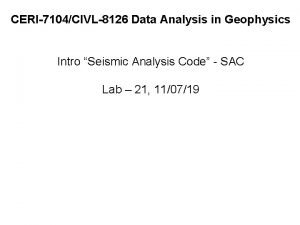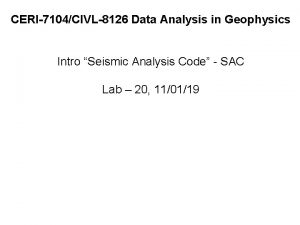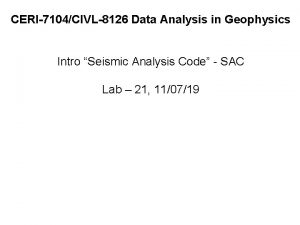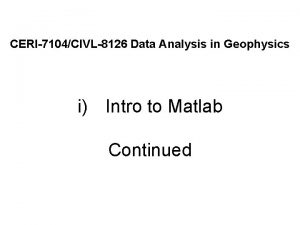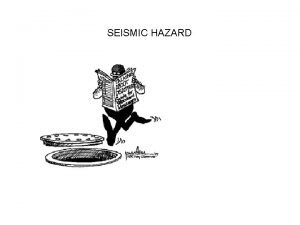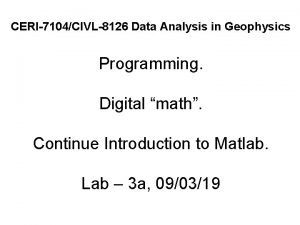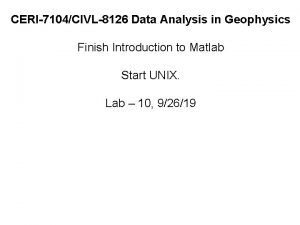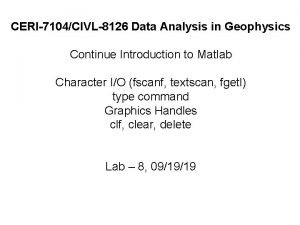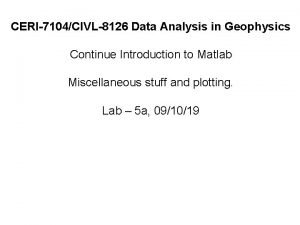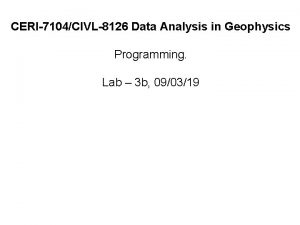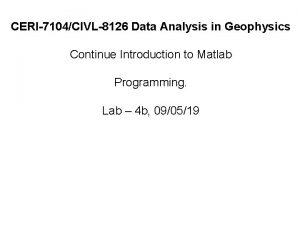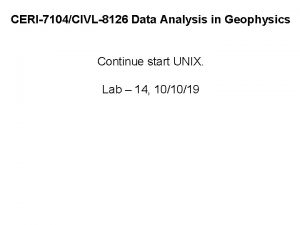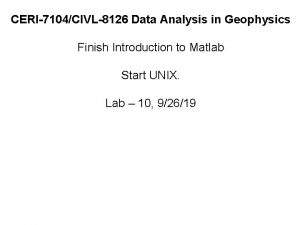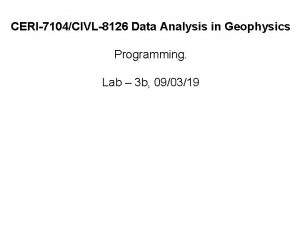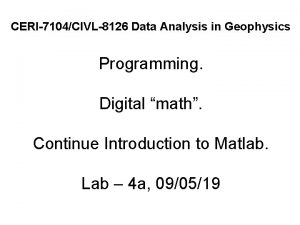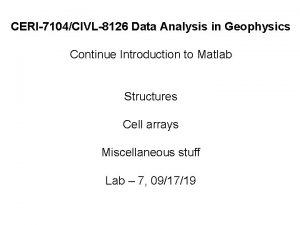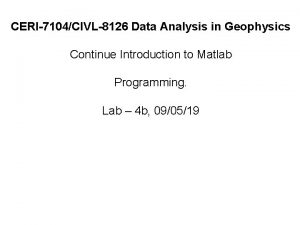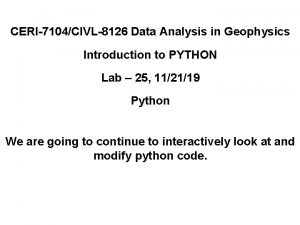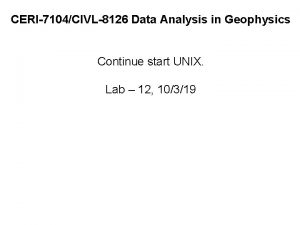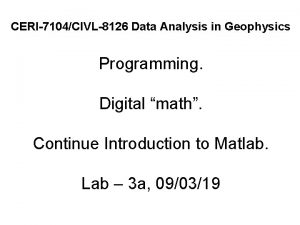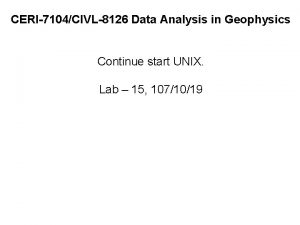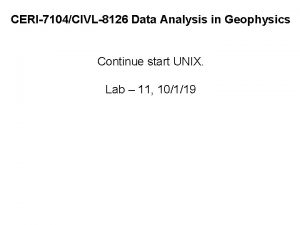CERI7104CIVL8126 Data Analysis in Geophysics Intro Seismic Analysis













































- Slides: 45

CERI-7104/CIVL-8126 Data Analysis in Geophysics Intro “Seismic Analysis Code” - SAC Lab – 21, 11/07/19

SAC online documentation https: //ds. iris. edu/files/sac-manual/manual. html

Can color traces (this is an addition since the TEK 401 X days – when it was green or nothing). SAC> color on increment on SAC> p 2 Sac> p 2 rel

Spectral Analysis Module (SAM): Spectral/Fourier Transform analysis. You can do a discrete Fourier transform fft and an inverse Fourier transform ifft You can also compute the amplitude and unwrapped phase of a signal (“unwrap”). This is an implementation of the algorithm due to Tribolet.

The fft and unwrap commands produce spectral data in memory. You can plot this spectral data plotsp

You can also perform - integration with divomega and - differentiation with mulomega directly in the frequency domain.

sac> funcgen seismogram sac> fft sac> plotsp Plots amplitude Then the phase after a <CR>

UNWRAP SAC> cut 3000 5000 SAC> read *india*bhz* SAC> qdp off SAC> p SAC> rtrend SAC> UNWRAP FILL OFF INTTHR 10 PVTHR 5 DC level after DFT is 53. 572 SAC> psp Plots amplitude Then the unwrapped phase after a <CR>

You can write it to disk as writesp and read in back in again readsp You have to know the data/file is spectral data. SAC will not figure it out.

Spectral Analysis Module (SAM): Spectral/Fourier Transform analysis. You can also correlate and convolve Has lots of options – see online man page https: //ds. iris. edu/files/sac-manual/commands/correlate. html

Convolution ex. Start with DWWSSN ”impulse response” – IR – what the seismometer records if you apply an impulse.

Convolution ex. If we zoom in we can see that the IR starts at 200 seconds and is done by 270 seconds.

Convolution ex. Now make a series of impulses and save them. fg impstrin 300 500 630 750 760 770 780 n 1024

Convolution ex. Read in file with IR & file with series of impulses and convolve them. Result is sum of series of weighted, shifted IRs.

Convolution ex. Zoom into the third signal.

Convolution ex. Zoom into the fourth signal. SAC> SAC> look SAC> fg impstrin 200 n 1024 transfer to DWWSSN w sac ir_200_l 1024. sac fg impstrin 300 500 630 750 760 770 780 n 1024 w sac imps. sac read ir_200_l 1024. sac imps. sac convolve at it, then zoom in xlim 770 910 at it, then zoom again xlim 940 1060 w sac ximps. sac 8 imps. sac

We can use the transfer command to “remove” the IR and recover the input to the seismometer. SAC> transfer from DWWSSN to none

Correlation ex. Correlation “looks for” one signal in another. Look for IR in the “seismograms”. It returns a set of weighted, shifted peaked functions.

Signal Correction Module These commands let you perform certain signal correction operations. - rmean: removes the mean from data. - rtrend: removes linear trend (and mean) from data.

- rglitches: removes glitches and timing marks. - taper: applies a symmetric taper to each end of the data and SMOOTH applies an arithmetic smoothing algorithm. - linefit: computes the best straight line fit to the data in memory and writes the results to header blackboard variables. - reverse: reverses the order of data points.

Integration – to change from acceleration to velocity, and velocity to displacement. SAC> r ccm_india_. bhz SAC> qdp off SAC> plot

Integrate it (original data was vel, integrate to disp). SAC> int SAC> p OOPS!

What is the problem? (do you agree that there is a problem? !)

Integral of constant is a straight sloping line. The seismic data has a (small) DC offset (a constant). So remove the mean.

Try again. SAC> r rmean int p OOPS again!

Is this an improvement? Are we getting any better? What’s the problem now?

Integral of linear fn (line) is a quadratic fn (parabola). So data has a linear trend - remove trend (line) from data (y=mx+b) (this will also remove the mean through the intercept b).

Remove trend (line) with rtrend, this removes y=mx+b – both the line and the DC offset SAC> rtrend Slope and standard deviation are: -0. 038705 0. 0037565 Intercept and standard deviation are: -2365. 1 15. 788 Data standard deviation is: 3010. 9 Data correlation coefficient is: 0. 026988 SAC> int SAC> p

Removing the line will also remove the mean if it is not zero. So don’t really need to do the rmean first.

There is still some “drift”, but this seismogram might be useful for displacement analysis. SAC> rtrend Slope and standard deviation are: -0. 038705 0. 0037565 Intercept and standard deviation are: -2365. 1 15. 788 Data standard deviation is: 3010. 9 Data correlation coefficient is: 0. 026988 SAC> int SAC> r more SAC> p 1 displacement velocity

Big problems with "baseline" drift when trying to integrate acceleration up to displacement to when trying to obtain/estimate co-seismic static displacement. Boore, 2001

Differentiation - default is 2 point difference y=(x 1 -x 0)/delta. sac> funcgen impulse delta 0. 01 npts 100 sac> dif sac> p

Differentiate velocity to acceleration. SAC> r SAC> dif SAC> p

More on correlation SAC> r *india*z SAC> correlate SAC> p What’s wrong here?

More on correlation SAC> fg boxcar p correlate p Boxcar Signal Correlation

More on correlation SAC> r *india*z rtrend correlate p Fix by removing mean with rmean, or better yet, remove trend (gets mean and linear) with

More on correlation SAC> r US. WRAK. . BHZ. M. 2011. 070. 055503. SAC *SCIA*Z* SAC> p 1

More on correlation SAC> rtrend SAC> correlate SAC> p 1

Binary Operations Module These commands perform operations on pairs of data files. - merge: merges (concatenates) a set of files to the data in memory.

Binary Operations Module - addf: Adds a set of data files to data in memory. READ FILE 1 FILE 2 ADDF FILE 3 FILE 4 READ FILE 1 FILE 2 FILE 3 ADDF FILE 4 - subf: subtracts a set of data files from the ones in memory.

- mulf: multiplies the data in memory by a set of data files. - divf: divides the data in memory by a set of files. - binoperr: controls errors that can occur during these binary operations. Can use to override the requirement for the same number of points and/or the sampling interval.

sac> sac> funcgen impulse delta 0. 01 npts 100 w impulse 1. sac div 2 w impulse 2. sac r impulse 1. sac addf impulse 2. sac Notice you have to write intermediate stuff out to disk.

Windowing SAC> SAC> funcgen sine 10 90 delta 0. 01 npts 100 TAPER TYPE HANNING WIDTH 0. 5 w sac taper 0. 5. sac funcgen sine 10 90 delta 0. 01 npts 100 r more. /taper 0. 5. sac color on increment on p 2

More - stretch -upsamples data, including an optional interpolating FIR filter. - decimate -downsamples data, including an optional anti-aliasing FIR filter (this is what qdp does without the filter). - Interpolate - interpolate evenly or unevenly spaced data to a new sampling interval using the interpolate command.

More - quantize -converts continuous data into its quantized equivalent. - rotate -pairs of data components through a specified angle. (we have already seen this one) - rq - removes the seismic Q factor from spectral data.
 Python for geophysics
Python for geophysics Csm geophysics
Csm geophysics Gel geophysics
Gel geophysics Wireline geophysics
Wireline geophysics Seismic data visualization
Seismic data visualization Deterministic seismic hazard analysis
Deterministic seismic hazard analysis Sac spectrogram
Sac spectrogram Seismic analysis code download
Seismic analysis code download Type of earthquake waves
Type of earthquake waves Smacna hangers and supports
Smacna hangers and supports Seismic waves
Seismic waves What are wavefronts
What are wavefronts Seismic
Seismic P wave animation
P wave animation Seismic quality control
Seismic quality control Seismic use group
Seismic use group Seismic restraint cable factories
Seismic restraint cable factories Seismic wave types
Seismic wave types Surface waves and body waves
Surface waves and body waves Uniform building code 1997
Uniform building code 1997 Aisc
Aisc The locations of seismic belts are determined by plotting
The locations of seismic belts are determined by plotting Asce 7-5
Asce 7-5 Retrofitting project report
Retrofitting project report Seismic design competition
Seismic design competition Eureka, ca seismic station s-p interval = seconds
Eureka, ca seismic station s-p interval = seconds Mozambique seismic
Mozambique seismic Seismic tomography ______.
Seismic tomography ______. Seismic waves are mechanical waves
Seismic waves are mechanical waves L wave
L wave Seismic waves
Seismic waves Low cost seismic acquisition
Low cost seismic acquisition Design of seismic-resistant steel building structures
Design of seismic-resistant steel building structures Seismic waves
Seismic waves Seismic wave cracker
Seismic wave cracker 7 seismic shifts
7 seismic shifts Seismic inversion
Seismic inversion Virtual seismic atlas
Virtual seismic atlas Seismic beach balls
Seismic beach balls Fourier transform seismic
Fourier transform seismic Seismic tomography
Seismic tomography Seismic isolation
Seismic isolation Seismic isolation
Seismic isolation Eureka, ca seismic station s-p interval = seconds
Eureka, ca seismic station s-p interval = seconds Seismic noise
Seismic noise Earthquake waves
Earthquake waves
